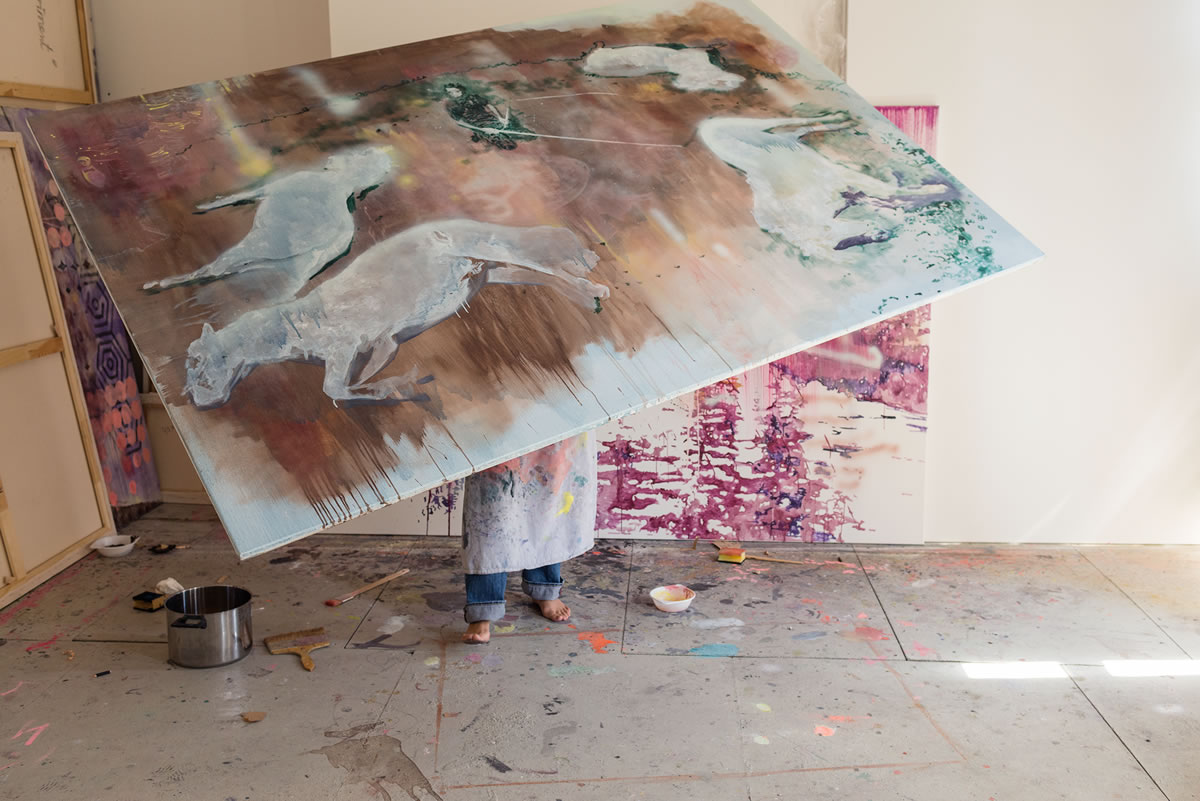KLAUS HARTMANN

Miriam Vlaming
Berlin, Germany
...Page is loading...

Berlin, Germany
"Miriam Vlaming was so kind to invite me to her Atelier to have a talk about her new work and her relation to the temporal aspects of being an artist. The expressional aspects of Miriam Vlaming´s newer artworks are primarily seen in the use of vivid, intense colors as well as how the characters are painted. They have gone from almost always being relatively anonymous – no facial expression, no mimic. The characters are no longer only...
Read more"Miriam Vlaming was so kind to invite me to her Atelier to have a talk about her new work and her relation to the temporal aspects of being an artist. The expressional aspects of Miriam Vlaming´s newer artworks are primarily seen in the use of vivid, intense colors as well as how the characters are painted. They have gone from almost always being relatively anonymous – no facial expression, no mimic. The characters are no longer only characters but subjects with emotions, direction and time. The vivid colors are combined with the special technique that reminds me of stencil techniques from street art – where layers on layers are continuously expanding the paintings in front of you.
In these works lies a new expanded temporality. This new temporality I find interesting – what role does time play in your work?
'Time plays an important role in my work – the practical aspects and process of not only preparing and mixing pigments also applying and working with layers upon layers on the canvas is simply put a very timeconsuming process where I need a lot of time. In that sense I work with different levels of abstraction – in the end I seek to create a sense and feeling that time stands still. Being able to fixate a point in time or to make time stand still can be seen as making a testimony – For any art, painting and photography I believe that this ability and desire “to make time stand still” is present and inherent to the artistic work.In a sense by working against a concept such as time that can be considered finite and what can be considered ephemeral – you make a testimony – a proof or evidence saying – I was here and even when I am no longer here a part of me will still be here. Representing a part of this human life and this reality.
On the one hand I have this desire related to time that influence my work and the process. On the other hand the temporal aspect plays an important role in the material from which I often draw my inspiration – Photographies – small frozen moments.'
Vlamings relationship to photography is close to what you could call a love-hate connection. Although she turns to photography for inspiration it also to some extend annoys her. Photography is too regulated so to say – it holds too little flexibility in relation to the outcome and result. The degree of predictability when working with canvas, paint and sprays are much lower compared to photography.Working with pigment, paint and canvas no reassurance is given in relation to how the process will move on or how the final painting will turn out. The artistic method used in relation to painting is much more dynamic and depends on several factors to be succesfull – such as skills, experience and strong point of view. Skills which Vlaming is in possession of...Somehow the visual expression in the paintings is not only motives and paint. In front of Vlamings work you sense the movement, emotion, inspiration, the process of mixing, preparing, layering, considering, waiting – you sense the time spent and you sense the point in time that the painting refers to. As if the motif and situation seen – brings the viewer to this particular part in time.It portrays an atmosphere – that one single moment in time where some people had a picnic that Sunday near the lake or the feeling you felt when you played in the garden. You can sense a force of joy, aerial lightness and strong will in the paintings that are fantastically refreshing and vivid...."
Extract from the interview: Linda Post with Miriam Vlaming, published 30. October 2014 on www.kaputte.com
(To read the whole interview click on http://kaputte.com/2014/10/30/your-sense-of-time/)
What is it about your studio space that inspires you?
Privacy and silence.
What sounds, scents and sights do you encounter while in your studio?
I listen to radio plays and all kind of music and I love silence.
What is your favourite material to work with? How has your use of it evolved throughout your practice?
Egg tempera on canvas.
What themes do you pursue?
Live and death and all in between, transience, individualism, existential, timelessness, collective subconscious and believe.
What advice has had the biggest impact on your career?
Find your passion and stay true to yourself.
If you could install your art absolutely anywhere, where would that be?
Places of silence.
If you could only have one piece of art in your life, what would it be?
One work of Piero della Franscesca.
If you weren´t an artist, what would you be doing?
hmm...a doctor?
What are your favourite places besides your studio?
My garden, the forrest, the sea.
ALTANA Kulturstiftung, Germany
KUNSTFONDS DES FREISTAATES SACHSEN, Germany
KUNSTSAMMLUNG DER DEUTSCHEN BUNDESBANK, Germany
show all
Galerie Sam Dukan, Paris + Leipzig | http://www.galeriedukan.com
Galerie Zerp, Rotterdam, Netherland | www.zerp.nl